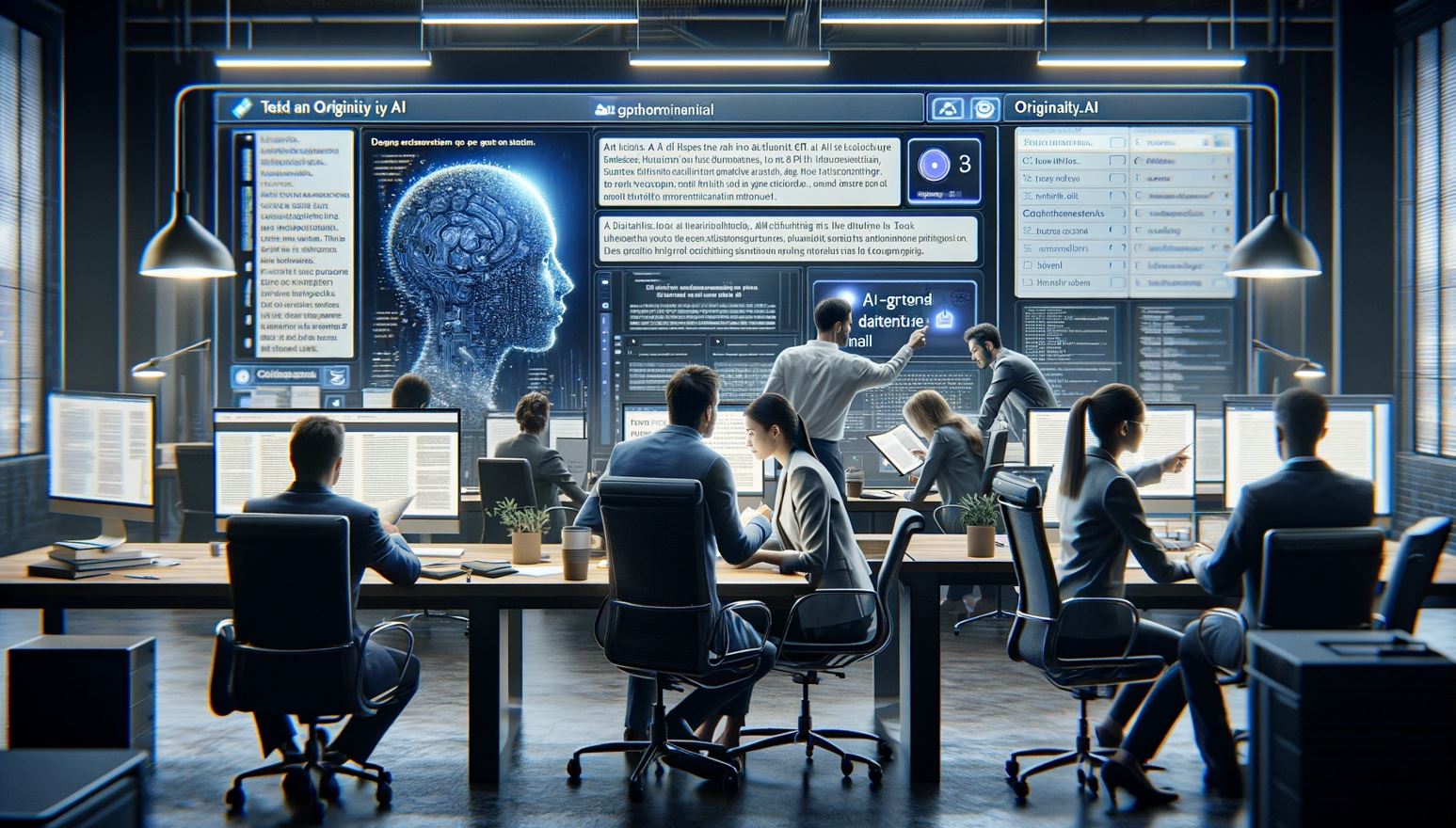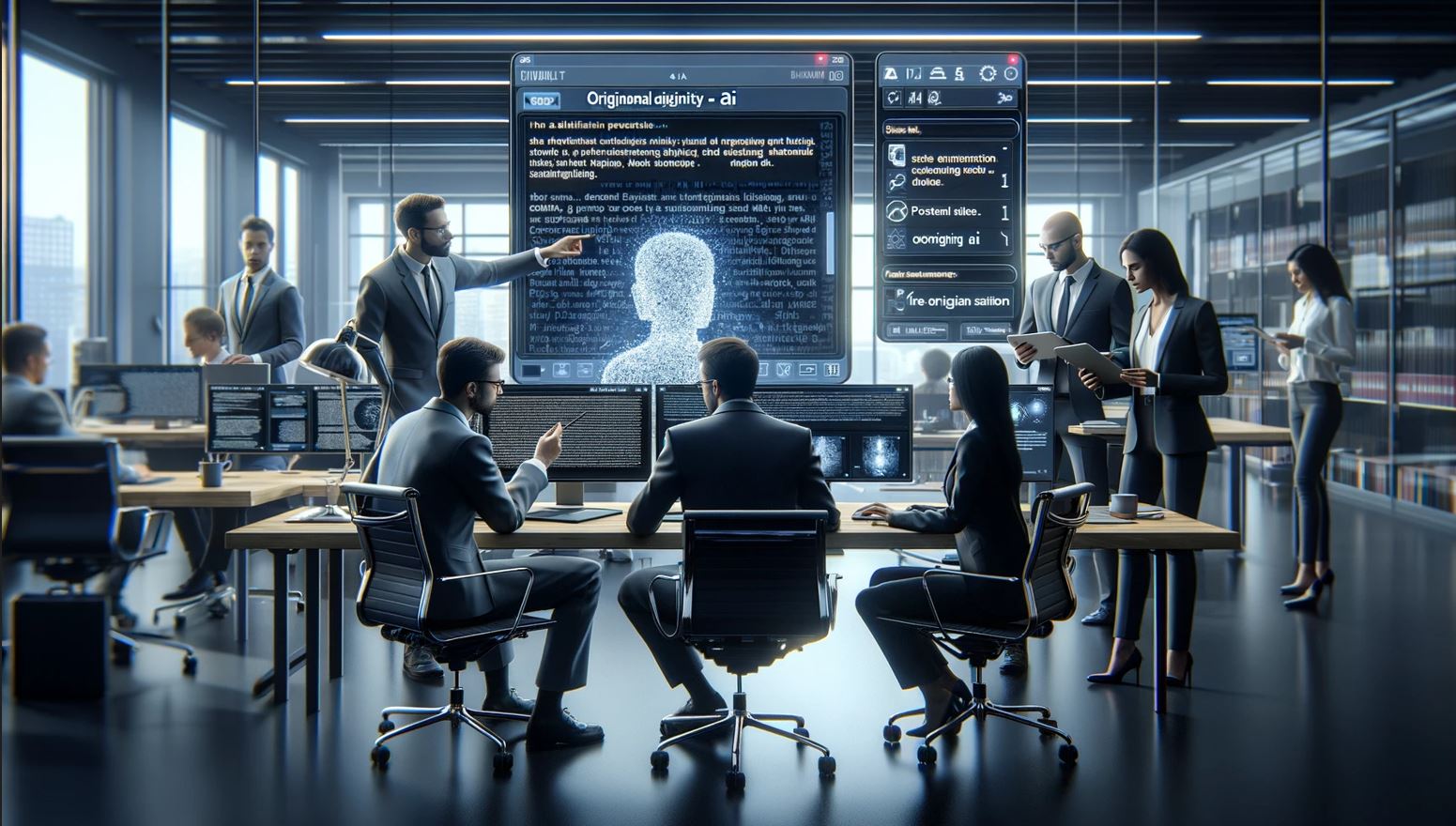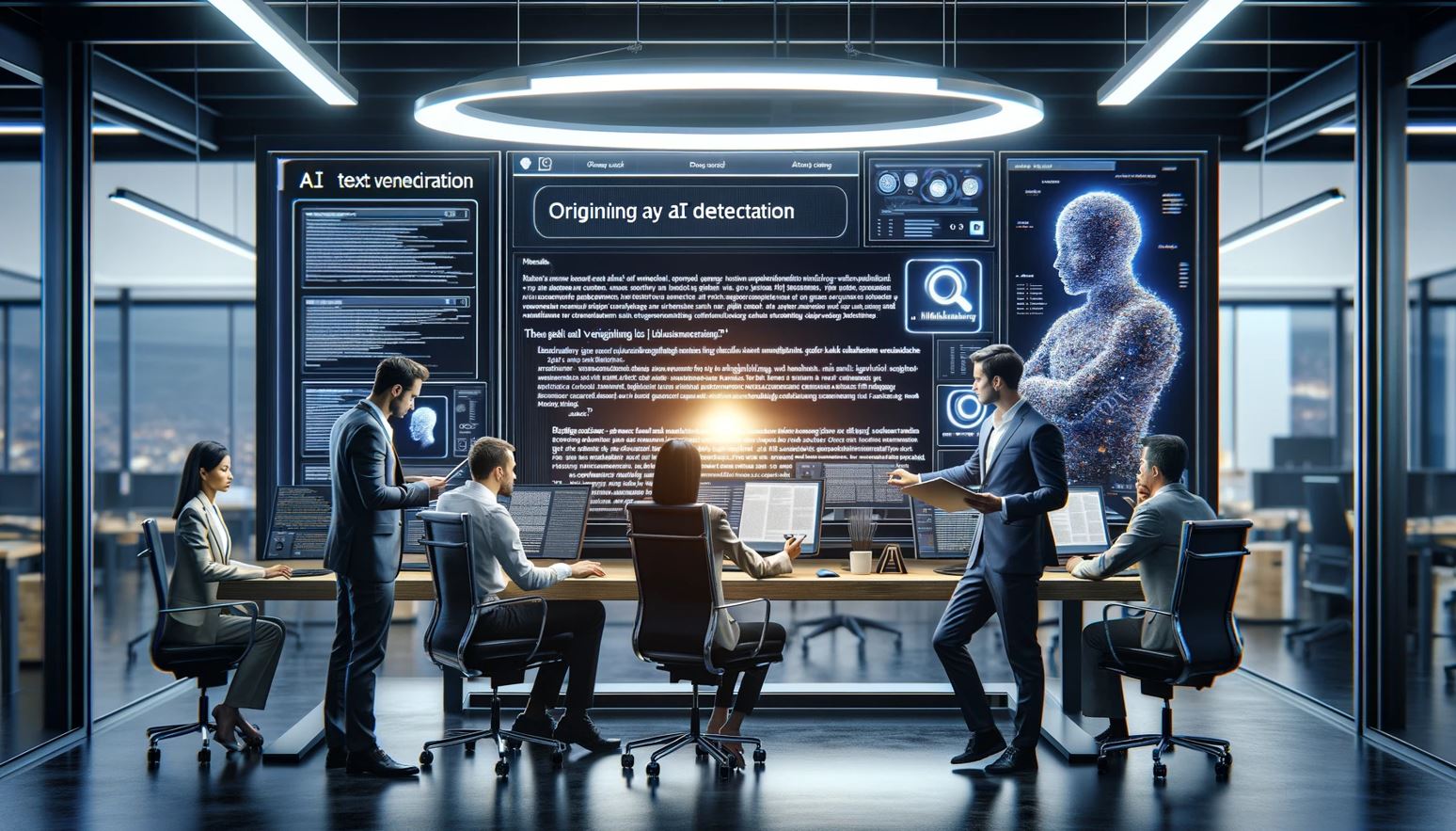A question often lingers in my mind nowadays each time I read an article online. I wonder to myself, is this text AI-generated?
This is now the quintessential riddle of our digital era.
Imagine trying to spot the difference between faux greenery and lush foliage from several feet away – it’s no small feat!

Try these new AI-powered tools:
- 5 Best AI Detectors To Unmask AI-Written Content With Accuracy
- 5 Best AI Writers To Boost Your Productivity And Content Quality.
- This "Secret AI Writer" Can Bypass AI Detection Like A Pro.
I totally understand the feeling – there I was, peering intently into my computer screen as though it held ancient secrets. That curiosity sent me down the rabbit hole of research, eager for answers on how to distinguish AI-generated content from human-crafted prose.
So gear up for a bit of detective work because this article isn’t just going to give you tips—it’s going to elevate you to expert status in identifying whether text has that unmistakable human warmth or synthetic precision.
Article At-A-Glance
- You can spot AI-generated text by looking for weird language, like sentences that don’t sound right or big words used in strange ways.
- AI has trouble with making things stick together and staying on topic, which can make the writing seem jumpy or not quite real.
- Text from an AI might repeat phrases a lot, kind of like someone telling the same story again and again.
- Checking facts or how words are put together can help you tell if a computer made the text. You might also use special computer tools to check if it’s AI-written.
- Experts know a lot about this stuff and can sometimes tell if writing is from an AI, but even they get tricked sometimes.
Table Of Contents
Is This Text AI-Generated?
Alright, folks, let’s dive into the digital rabbit hole and play detective—could this very text you’re reading be the brainchild of an AI?
I mean, imagine the plot twist if it turned out that these words were not penned by a human but rather carefully crafted by lines of code and algorithms whispering sweet nothings to each other!
Unnatural Language Or Grammar
So, you’re reading something and it hits you—this doesn’t sound quite right. The words seem off or the sentences don’t flow like a normal conversation would. That’s a red flag there! Maybe an AI is behind this.
I’ve seen how these machines can get tripped up on grammar and syntax—the rules that make our language work smoothly. They might toss in big words where simpler ones fit better or repeat the same phrases over and over.
Here’s what gets me: AI-generated text often shows patterns that just aren’t human-like. You know how we tend to mix things up when we talk? Well, AI may not be so good at that game yet.
We humans are pretty unpredictable with our word choices, but an AI tends to cling onto certain terms like they’re its favorite toy—it keeps throwing them into the mix way too often.
We humans are pretty unpredictable with our word choices, but an AI tends to cling onto certain terms like they’re its favorite toy—it keeps throwing them into the mix way too often.
If you spot writing where it feels like someone has hit copy-paste on specific words or structures, chances are it could be our robot friends trying their hand at playing author!
Lack Of Coherence And Context
Sometimes, you can tell a piece of writing came from AI because it just doesn’t quite stick together. It’s similar to when I try to tell a story but jump all over the place—my friends get lost! AI has this problem too.
It tries really hard, breaking text into little bits called tokens and gluing them back together. But here’s the thing: it only sees a small bit of text at a time. Imagine trying to solve a puzzle with half the pieces missing. That’s what AI is dealing with.
AI tools sometimes throw in lots of words that seem smart or join ideas to make everything flow better—or look like it does! They use these fancy ties—cohesive devices—and they do help connect sentences sorta like bridges between islands.
But even with those bridges, things can get shaky if you don’t know what’s going on in each island’s story. That’s why some texts feel off—they lack that deep understanding we humans naturally have when we chat about stuff.
Repetitive Patterns
I’ve noticed something funny with the texts that machines write. They often repeat the same things over and over. This is like a big sign saying, “Hey, an AI wrote this!” It’s one of those top tricks to spot if content is coming from a robot instead of a person.
Imagine a friend who keeps telling the same story every time you see them—that’s how AI text can feel!
Computers aren’t great at being random or coming up with new ideas. So they might use certain words too much or say similar sentences again and again (think “patterned text” or “repetitive language”).
If I read an article and it feels like I’m going in circles, that’s probably because an algorithm put it together—kind of like getting lost in a maze made out of words.
If I read an article and it feels like I’m going in circles, that’s probably because an algorithm put it together—kind of like getting lost in a maze made out of words.
But hold on, there’s more than just writing to think about!
Use f Uncommon Vocabulary Or Phrases
Sometimes, I’ll read something and think, “Wow, that word is fancy!” That’s one clue the text might have been made by a computer. AI can throw in big words that seem out of place or use phrases we don’t usually hear.
You can compare it when someone tries to sound smart using words nobody uses in everyday talk—it can sound odd.
AI doesn’t always get it right with new or complex words. Sure, it aims to impress us but might overdo it. So if you bump into text where every other word makes you reach for a dictionary, there’s a chance AI had its hand—or should I say circuit—in it.
Now let’s look at how understanding AI-generated text helps us spot these quirks!
Understanding AI-Generated Text
Now, let’s dive into the wild world of AI-generated text and uncover how these smarty-pants machines string words together. Trust me, it’ll be like unraveling a digital mystery novel with no pages missing! Keep reading to see what I mean.

Definition Of AI-Generated Text
AI-generated text is like a robot writing a story. Think of it as having a digital pen pal that’s actually a computer. This smart machine uses something called artificial intelligence, or AI for short, to make sentences and paragraphs.
It gets really good at guessing what word should come next by looking at tons of other words and learning patterns.
Now, in my own experience with this tech stuff, the results can be pretty wild. Sometimes the text it makes feels like magic—it’s smooth and sounds just like a human wrote it!
Other times, let’s just say you’d know it was written by a machine because things get all jumbled up or don’t make much sense. But guess what? It’s getting better every day!
How AI Generates Text
So, let’s dive into the magic behind AI text generation. Think of it like a chef using lots of recipes to whip up a new dish. The artificial intelligence has read tons—really, tons—of text from all over the web.
Then it learns patterns and styles in language, just like you pick up slang from hanging out with friends.
The big star in this show is something called natural language processing or NLP for short. It helps the AI understand human talk and even write things that seem like a person did it!
With tools such as generative pre-transformer (GPT), these smart programs take all they’ve learned—from blogs to tweets—and create their own pieces that are often tricky to tell apart from human-written stuff.
Now, just imagine what happens when these AIs get better at mimicking us.
Implications Of AI-Generated Text
Oh, the twists and turns of AI-generated text! From blurring the lines between fact and fiction to sparking some serious ethical debates, it’s as if we’re all characters in a plot thickening so fast we can barely keep up—wanna dive in deeper? Keep reading.
Potential For Misinformation Or Fake News
So, let’s chat a bit about how AI might mix up the news game – and not always in a good way. Imagine you’re scrolling through your feed, and bam! You see this crazy headline with local-looking images saying something wild happened downtown.
But wait! It could be totally made-up stuff, thanks to AI getting really good at crafting fake news that seems legit.
I’ve seen articles talking about how folks are using AI to whip up all sorts of bogus stories—complete with photos that look super real.
It’s kinda scary when you think about it because it’s tough to tell what’s true or just some hallucinated information an AI dreamed up.
It’s kinda scary when you think about it because it’s tough to tell what’s true or just some hallucinated information an AI dreamed up.
They call this “AI-generated disinformation,” and guess what? It does sound like something out of a sci-fi movie.
The problem is big. We’re already swimming in misleading info online without throwing tech-driven fakes into the mix. What I’m saying is, even though these tools can do some pretty neat things for creativity and biz, they can also churn out deceptive content like nobody’s business if they get into the wrong hands.
And as much as I’d love to say there’s an easy fix—there isn’t one yet ’cause tracking down this kind of sneakiness takes serious detective work.
Ethical Concerns
So, let’s talk about the tricky parts of AI writing stuff. It’s not all fun and games—there are serious questions to think about. Imagine a world where computers write fake news left and right.
Not cool, right? People could get hurt if they believe lies or get confused by made-up stories. Plus, there’s this whole mess with privacy—I mean, who wants a robot snooping around your personal business?
Now add in the bit about folks not knowing if what they’re reading came from a human heart or some lines of code. That can shake up trust real quick!
And you’ve got to wonder: is it fair when someone snatches your smart words without asking? All this makes my head spin—but the fact is, we’ve got to deal with these moral headaches because that’s what keeps things on the straight and narrow.
Alrighty then, shifting gears.
Impact On Content Creation And Journalism
Imagine writing stories that hit the heart every time. That’s what journalists dream of, right? But here comes AI, churning out articles at lightning speed. Sure, these machine-penned pieces might nail grammar and facts, but they sometimes miss the soul of storytelling—the human touch that makes you feel stuff.
I think about how robots don’t get writer’s block or need coffee breaks, and it seems great for pumping out content fast.
Now let’s talk about ethics—that big word that keeps us up at night. Using AI to create stories raises some serious questions. Is it a fair game or a step toward fake news?
What if an AI writes something hurtful without understanding the impact? And don’t even get me started on plagiarism! The rules are blurry when machines mix and match words like puzzle pieces.
As someone who loves crafting tales with care, I wonder if we’re ready for this new digital chapter in journalism and content creation.
Verifying The Authenticity Of Text
So, you’ve got a hunch that something’s fishy about the latest viral article zooming across your feed. I get it. In this digital Wild West of words, who knows what’s real and what’s just clever code masquerading as human wit?
But fear not—I’m here to hand over my magnifying glass and show you how detective work isn’t just for Sherlock anymore. We’re all on the case now!

Fact-Checking And Cross-Referencing Information
I always double-check the facts in a text, especially if it might be AI-generated. It’s kind of like being a detective, looking for clues to tell if something is real or not. I use reliable sources—trusted websites and databases—to see if what the text says matches up with the truth.
Sometimes, I’ll even check out fact-checking sites that are made just for this purpose.
Cross-referencing is my go-to move. I compare information from different places to make sure everything lines up correctly. If one source says one thing but another doesn’t agree, it makes me think twice about what’s true.
And you know what? Using AI tools can speed this up big time! They can dig through tons of information quickly and help me find out if something was made by a computer or a real person.
Analyzing Writing Style And Patterns
Okay, let’s dive into how we figure out if a text is cooked up by AI. I look at how the words flow and the way they’re put together. Sometimes, AI-written stuff feels off – you know, like when sentences are too perfect or just repeated over and over.
It’s sort of like that friend who tells the same story every time you see them.
I also get clues from the rhythm of the writing and whether it sounds natural. Real people tend to mix things up – a long sentence here, a short one there – kind of like music with different beats.
I also get clues from the rhythm of the writing and whether it sounds natural. Real people tend to mix things up – a long sentence here, a short one there – kind of like music with different beats.
AI? Not so much. It can be more like a robot dancing to the same song on loop!
And tone? That’s my secret weapon for sniffing out AI-generated text. If it reads flat or doesn’t have those sweet human touches (like humor or emotions), then bingo – might not be written by a person after all!
Consulting Experts Or Using AI Tools For Detection
So, you think a piece of text might be from an AI? I’d reach out to the pros or use some nifty AI tools for help. It’s kind of like playing detective with words. You’ve got tools like Originality.ai that can do more than just spot if something’s written by a robot—they check for copied stuff and facts, and even how easy it is to read.
And then there’s the ChatGPT Detection Tool everyone’s talking about. People trust it to tell if writing is really coming from someone pounding on a keyboard or just lines spat out by a clever program.
Let me spill the beans on another secret weapon: experts! Sometimes you want someone with smarts to give things a once-over, especially when those detection gizmos spit out maybes instead of yes-or-no answers.
They know their stuff because they keep up with all the tricks these wordy AIs pull. Sure, these brainy folks aren’t foolproof and sometimes get tripped up thinking bot-written blurbs are human-made. But let’s face it! Nobody’s perfect!
Stay Ahead In This High-Tech World
Wrapping up, we’ve seen that texts can be tricky to figure out if they’re from AI or not. Still, with the tips I gave you, checking text is easier and smarter now. Remember how important it is to know who wrote what—a real person or computer? This matters a lot today.
Want more help? There are tools and experts out there ready to guide you. Go on—use these ideas and stay ahead in this high-tech world!
FAQs
1. How can I tell if a text is AI-generated?
Look for patterns or phrases that seem too repetitive or don’t quite sound like how a person would talk.
2. Will an AI-written text make mistakes?
Yep, even AI can slip up and make spelling or grammar mistakes—nobody’s perfect!
3. Can AI write stories just like humans do?
AI can definitely try to write stories, but they might miss that human spark or emotions we all love.
4. Is it easy to spot an AI-generated text?
Sometimes it’s tricky. Other times, you’ll notice something’s off because the writing lacks personal touches.
5. Do people use AI to write books and articles?
You bet—some folks use AI to help churn out content faster than brewing a cup of coffee.
Meet our resident tech wizard, Steve the AI Guy. Now, before you get any wild ideas, let’s clear up one thing – he’s 100% human! I mean, he’s got the work history to prove it. He spent a decade diving into the deep end of the tech industry doing business intelligence work, splashing around with two of the world’s largest business consulting companies, Deloitte and Ernst & Young. Learn More

